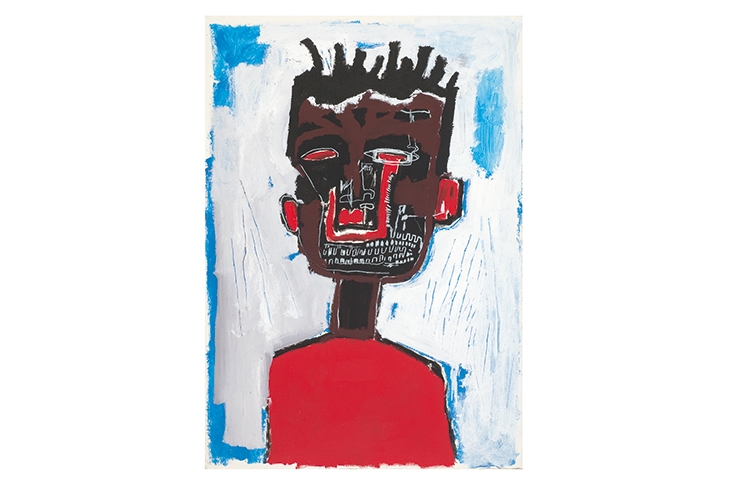‘Art by its very essence is of the new… There is only one healthy diet for artistic creation: permanent revolution.’
Jean Dubuffet wrote those words in 1963, and when Jean-Michel Basquiat burst on to the New York art scene 20 years later — barely out of his teens, untrained and black — he seemed to embody them. Together with his friend Al Diaz, he had grabbed attention in the late 1970s with a campaign of cryptic graffiti signed SAMO© targeted on the SoHo gallery district. Born to middle-class Haitian-Puerto Rican parents in the South Bronx, Basquiat didn’t waste time tagging trains. He knew the value of location; his dad was an accountant.
Photographs of the graffiti fill a room in the Barbican’s exhibition Basquiat: Boom for Real. ‘SAMO© As An Alternative 2 ‘Playing Art’ With The ‘Radical? Chic’ Sect On Daddy’$ Funds’ reads one; ‘SAMO© As A Result Of Overexposure’ reads another. Later, after the Village Voice blows the pair’s cover, comes the announcement ‘SAMO© Is Dead’.
The death of SAMO© the graffitist marked the birth of Basquiat the artist. Soon the lanky kid who had once peddled postcards for a dollar outside MoMA was being invited to contribute to high-profile exhibitions: after showing in New York/New Wave in 1981 he was greeted by the critic Peter Schjeldahl as ‘a kind of street Dubuffet (who says he never heard of Dubuffet)’. Inevitably, he was taken up by Warhol, whom he wooed with a double-portrait, ‘Dos Cabezas’ (1982), in which Jean-Michel’s dreadlocks tangle with Andy’s fright wig. His artistic independence survived their subsequent collaboration, his youthful unselfconsciousness did not: in a photo taken in Zurich in 1982 the expression behind Basquiat’s dark glasses is a perfect replica of Warhol’s pained poker face.
The downtown art world was wowed by the wonder child. How did you learn, interviewers asked him? By looking, he said. And look he did, at an astonishingly wide range of artists from Leonardo and Titian to Picasso and Dubuffet. His catalogue of Dubuffet’s 80th birthday retrospective at the Guggenheim Museum in 1981 shares a display case with his copy of a book on Leonardo. He had the omnivorous appetite of the autodidact. ‘Originally I wanted to copy the whole of history down,’ he told one interviewer, ‘but it was too tedious so I just stuck to the cast of characters.’ Picasso and Titian are honoured with appearances in paintings, but the achievements of Rauschenberg, Lichtenstein, Duchamp and Pollock are summed up in bullet points on brown wrapping paper — a casual put-down from a kid with the world at his feet who never imagined he could be put in a box.
He knew he could paint; the question, as always, was what to paint about. The obvious answer was his racial heritage. He developed a sign language of African masks and voodoo skeletons, floated against bright colour fields with lists of attributes and associations scrawled like workings-out in the margin. His paintings celebrated the achievements of black Americans — sportsmen, actors, but especially musicians — while highlighting their tokenism. They drew on his music library as much as his art library: the images of Louis Armstrong and other jazz musicians in ‘King Zulu’ (1986) were based on photographs in his paint-smeared copy of Black Beauty, White Heat: A Pictorial History of Classic Jazz. He painted while listening to music, sampling and scratching like a DJ, transposing rhythms and themes, track titles, record numbers and musical notation into paint. When he didn’t work to music, he played film videos. ‘I have to have some source material around me to work off,’ was his explanation. He was in constant need of stimulation, artistic and — increasingly —chemical.
His best work is from his 1982 show with the Annina Nosei Gallery, before the blue-chip dealers got him in their clutches: the skull-headed boxer with the crown of thorns in ‘Untitled’ (1982) is a powerful image. I’ve never seen paintings better suited to the Barbican Gallery’s brutalist concrete walls, but the work gets repetitive. Much of it is sketchy: done in a rush, it can be consumed quickly. Where did it go wrong? A group photo marking the artist’s 25th birthday in December 1985 offers a clue. In a crowd of party people his is the only black face: making art about being black for a white audience had put him in a box.
If he hadn’t died from an overdose in 1988, would he still be around in 2040 to enjoy an 80th birthday retrospective like the endlessly self-renewing Dubuffet? Going round Pace London’s current show of Dubuffet’s ‘Théâtres de mémoire’, started when the artist was in his mid-70s, I wasn’t sure. The experience of standing in front of one of these monumental works, like mansions of the mind from which the fourth wall has been removed, is richer on so many levels: unlike Basquiat’s fragmented images, which would float away if not tethered by text, the scribbly cartoon figures and biomorphic abstract patterns in Dubuffet’s crowded collages hang together in an impossibly harmonious whole. The mind ‘recapitulates all fields; it makes them dance together,’ explained the artist. ‘It also transforms them, cooks them in its sauces…’ Basquiat’s art has a greener sort of rawness than Dubuffet’s personal brand of art brut. His images dance but his ingredients are uncooked, ranged on the chopping board beside their scribbled recipes, lacking the sauces of memory he hadn’t time to form.






Comments